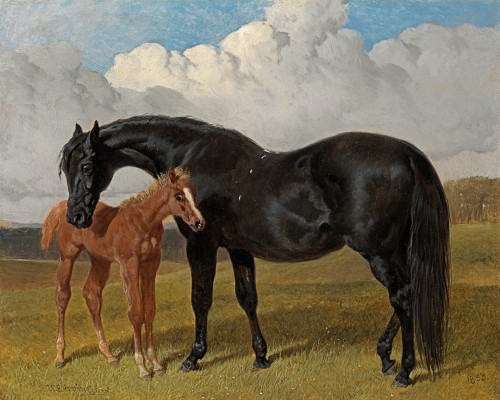SIR ALFRED MUNNINGS
Mendham 1878 - 1959 Dedham
Ref: CA 252
Early morning, Newmarket
Signed lower right: A.J.Munnings
Oil on panel: 22 x 73 7/8 in / 55.9 x 187.6 cm
Frame size: 27 ½ x 79 in / 69.8 x 200.7 cm
Painted circa 1950
Provenance:
TH Lawley;
Richard Green Gallery, London, 1969;
John, 8th Marquess of Waterford (1933-2015);
by descent
Exhibited:
London, Royal Academy, 1950, no.203
Literature:
Sir Alfred Munnings, The Finish, London 1952, illus. opposite p.208
When racing at Newmarket resumed properly after the end of the Second World War, Alfred Munnings once again made frequent journeys from his house in Dedham through the beautiful Suffolk countryside to the birthplace of horseracing. Many of his paintings from the 1940s and 50s explore racing Starts, parade rings and the gallops on the undulating, windy heathland where future champions were put through their paces.
In the summer of 1947, Munnings would go up to Warren Hill or Newmarket Heath early in the morning and watch ‘Strings of horses – returning along the chalk tracks from canters or gallops…lit by the long, golden rays, their shadows cast far ahead…When they came to the start of the canters, a head-lad stopped his horse, while the rest went farther on, then turned again towards him. Some horses, more restive than others – dancing sideways, capering, rearing, bounding – dashed off in pursuit of those ahead…What books did I fill with hundreds of drawings and notes!’[1].
As this painting shows, Munnings was fascinated by the action and personality of the horses and also that of the lads: how they rode, ‘the way they dress…the shape of their skulls’[2]. The forward thrust of the confident bay in the lead is held in tension by the curvetting chestnut in the foreground, which appears to have other ideas. The sense of movement is enhanced by Munnings’s broad, swift brushstrokes, evoking light playing over glossy coats, and by hooves which are blurred, as if too fast to see.
The innovative, elongated shape of this panel enhances the feeling of exhilaration, the breezy panorama of the gallops. Munnings describes the genesis of the format in the third volume of his autobiography, The Finish (1952): ‘Filling pages of notebooks at the canters on Warren Hill before and after breakfast. I began each afternoon – with the scene fresh in mind – setting out ideas on three six-foot panels: doors of an old wardrobe from Lady Ludlow’s house by the plantations at the top of Warren Hill. These excellent doors were discovered in the premises of a painter and decorator in Newmarket. Hanging one of the panels on a shady wall in a friend’s garden behind his house, I worked in the most perfect light, to the chirruping of sparrows as they washed themselves in the shallow bath almost at my feet, and the sound of a blacksmith's anvil across the road. Unruly horses starting up the canter, one after another, a string of horses coming off the Heath were the subjects. My mind was literally steeped in horses. The long shape of the panels was new and interesting’[3].
Munnings made three paintings, including the present one, using this ‘wardrobe door’ format, all around 73 inches in length. One, Coming off the Heath, exercising the horses, Newmarket is in the Munnings Museum, Dedham[4]. Two were exhibited as Early morning, Newmarket at the Royal Academy in 1950. The present painting was no.203, while the version depicting a dappled grey on the left was no.207 (private collection).
Susan Morris
SIR ALFRED MUNNINGS, PRA, RWS
Mendham 1878 - 1959 Dedham
Born in Mendham, Suffolk, Alfred Munnings was the son of a miller. He was apprenticed to a firm of lithographers from 1893 to 1898 and studied at the Norwich School of Art and in Paris. There he was impressed with plein-air naturalism; this, together with his introduction to the racecourse in 1899, influenced the themes for which he became famous.
While in Mendham, Munnings painted many scenes of country life, particularly horse fairs. He went to Cornwall in 1908, and for many years was an important addition to the Newlyn School of artists. When the First World War broke out, Munnings enlisted, despite having the use of only one eye owing to an accident in 1899. He became an army horse trainer near Reading and later went to France as an official war artist, attached to the Canadian Cavalry Brigade.
The year 1919 was a major turning-point in all aspects of Munnings's life; he painted his first racehorse, Pothlyn, the winner of the Grand National, and became an Associate of the Royal Academy. He met Violet McBride, whom he was to marry, and bought Castle House, Dedham, where the Munnings Memorial Trust maintains a permanent exhibition of his pictures. Munnings's prolific career, spanning over 60 years, brought him honour, with election to the Presidency of the Royal Academy in 1944, a Knighthood in 1945, and a personal award from the Sovereign in 1947, when he was created Knight of the Royal Victorian Order.
[1] Sir Alfred Munnings, The Finish, London 1952, p.181.
[2] Munnings, op. cit., p.181.
[3] Ibid., p.182.
[4] Oil on board, 23 x 72 in / 58.4 x 182.9 cm; Oil Paintings in Public Ownership in Essex: Sir Alfred Munnings Art Museum, London 2004, p.133, illus. in colour.




























